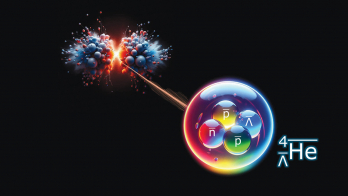
The ATRAP experiment at CERN’s Antiproton Decelerator has detected and measured large numbers of cold antihydrogen atoms. Relying on ionization of the cold antiatoms when they pass through a strong electric field gradient, the ATRAP measurement provides the first glimpse inside an antiatom, and the first information about the physics of antihydrogen.
ATRAP’s technique relies on trapping positrons between two bunches of antiprotons in a nested trap structure. The positrons are used to cool the antiprotons, and when they both reach a similar temperature, some combine to form antihydrogen atoms (a positron orbiting an antiproton nucleus). Being electrically neutral, these antiatoms drift out of the trap. Those that move along the axis of the apparatus soon find themselves traversing a strong electric field that strips off the positrons, thereby allowing the negatively charged antiprotons to be trapped and counted. “This measurement is completely background-free,” explains ATRAP spokesperson Jerry Gabrielse of Harvard University, “since the only way that a signal is detected is if antiprotons escape the nested trap in the form of neutral antihydrogen atoms.”
The ATRAP team has measured the field needed to ionize the antihydrogen atoms. The result shows that the antiatoms are formed in highly excited states (between n = 43 and n = 55). This is being interpreted as pointing to a three-body recombination scheme where a third body carries away the energy and momentum liberated by the antiatom’s formation. The ATRAP method has allowed the first measurement of the physics of antihydrogen, and is a step towards the precision measurements that will allow matter-antimatter comparisons to be made. The ultimate goal is to trap antihydrogen atoms and study their spectra with the same precision as for plain hydrogen (a few parts in 1014 for an analysis of the transition from the n = 2 to the n = 1 state).
The news comes shortly after another CERN experiment, ATHENA, announced its observation of cold antihydrogen. Using a completely different detection technique to ATHENA, and providing the first glimpse into the internal structure of antihydrogen, ATRAP has shown that CERN researchers are well on the way to understanding the first entry in the periodic table of the anti-elements. ATHENA and ATRAP use similar techniques for trapping the ingredients of antihydrogen, developed over many years by Gabrielse’s team. The fact that they use different detection methods reinforces the result, and is a good omen for future studies of antihydrogen at CERN.







